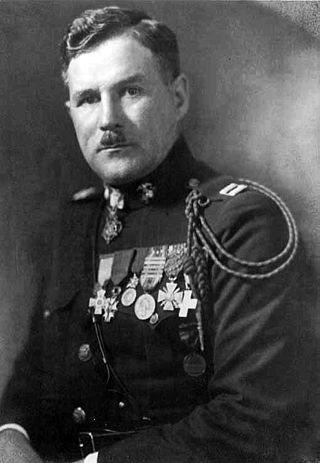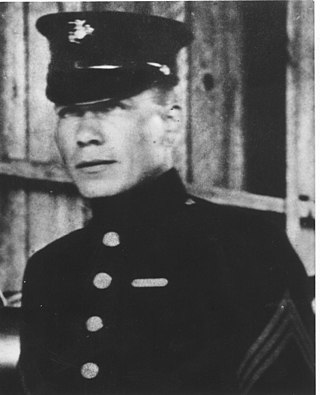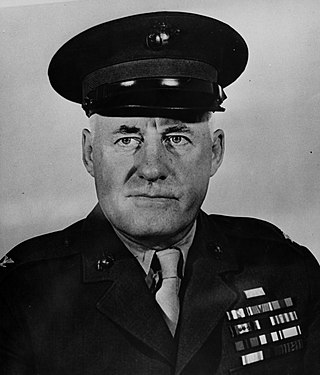
The Bronze Star Medal (BSM) is a United States Armed Forces decoration awarded to members of the United States Armed Forces for either heroic achievement, heroic service, meritorious achievement, or meritorious service in a combat zone.

The Legion of Merit (LOM) is a military award of the United States Armed Forces that is given for exceptionally meritorious conduct in the performance of outstanding services and achievements. The decoration is issued to members of the eight uniformed services of the United States as well as to military and political figures of foreign governments.

The Defense Superior Service Medal (DSSM) is a military decoration of the United States Department of Defense, which is presented to United States Armed Forces service members who perform superior meritorious service in a position of significant responsibility.

Holland McTyeire "Howlin' Mad" Smith, KCB was a general in the United States Marine Corps during World War II. He is sometimes called the "father" of modern U.S. amphibious warfare. His nickname, "Howlin' Mad" Smith, had been given to him by his troops in the Dominican Republic in 1916.

Ben Hebard Fuller was a major general in the United States Marine Corps and served as the 15th Commandant of the Marine Corps between 1930 and 1934.
The World War II Victory Medal is a service medal of the United States military which was established by an Act of Congress on 6 July 1945 and promulgated by Section V, War Department Bulletin 12, 1945.
The Vietnam Service Medal is a military award of the United States Armed Forces established on 8 July 1965 by order of President Lyndon B. Johnson. The medal is awarded to recognize service during the Vietnam War by all members of the U.S. Armed Forces provided they meet the award requirements.

Louis Cukela was a Croatian American United States Marine numbered among the nineteen two-time recipients of the Medal of Honor. Cukela was awarded the Medal by both the US Army and the US Navy for the same action during the Battle of Soissons in World War I. He was also awarded decorations from France, Italy, and Kingdom of Yugoslavia.
The Korean Service Medal (KSM) is a military award for service in the United States Armed Forces and was established November 8, 1950, by executive order of President Harry Truman. The Korean Service Medal is the primary US military award for service or participation in operations in the Korean area during the Korean War between June 27, 1950, and July 27, 1954.

The Sampson Medal was a U.S. Navy campaign medal. The medal was authorized by an Act of Congress in 1901. The medal was awarded to those personnel who served on ships in the fleet of Rear Admiral William T. Sampson during combat operations in the waters of the West Indies and Cuba. The Sampson Medal was also known as the West Indies Naval Campaign Medal, not to be confused with the West Indies Campaign Medal which was a separate award. A similar commemorative decoration was the Dewey Medal, considered senior to the Sampson Medal.
The American Defense Service Medal was a military award of the United States Armed Forces, established by Executive Order 8808, by President Franklin D. Roosevelt, on June 28, 1941. The medal was intended to recognize those military service members who had served on active duty between September 8, 1939, and December 7, 1941.

The Iraq Campaign Medal (ICM) is a military award of the United States Armed Forces which was created by Executive Order 13363 of U.S. President George W. Bush on 29 November 2004, and became available for general distribution in June 2005. The medal was designed by the U.S. Army Institute of Heraldry and was awarded during the Iraq War, from 19 March 2003 to 31 December 2011.
The Navy Occupation Service Medal is a military award of the United States Navy which was "Awarded to commemorate the services of Navy, Marine Corps and Coast Guard personnel in the occupation of certain territories of the enemies of the United States during World War II" and recognized those personnel who participated in the European and Asian occupation forces during, and following World War II. The medal was also bestowed to personnel who performed duty in West Berlin between 1945 and 1990.
The Dewey Medal was a military decoration of the United States Navy which was established by the United States Congress on June 3, 1898. The medal recognizes the leadership of Admiral of the Navy George Dewey, during the Spanish–American War, and the Sailors and Marines under his command.
The Spanish Campaign Medal was a military award of the United States Armed Forces which recognized those men of the U.S. military who had served in the Spanish–American War. Although a single decoration, there were two versions of the Spanish Campaign Medal, one for men of the United States Army and another for the forces of the United States Navy and United States Marine Corps.

George Barnett was the 12th Commandant of the United States Marine Corps. He was a pioneer of amphibious warfare and the U.S. Marine Commandant during American involvement in World War I.

Joseph Anthony Glowin was a United States Marine who received the Medal of Honor for heroism in combat in the Dominican Republic in 1916.

Roswell Winans was a highly decorated United States Marine, who as a First Sergeant earned the Medal of Honor during combat in the Dominican Republic. He was later commissioned and served as a company officer with the 5th Marine Regiment in France receiving several citations for bravery in combat.

Ernest Calvin Williams was a United States Marine Corps officer who received the Medal of Honor for his actions on November 29, 1916, during the Battle of San Francisco de Macoris. Then 1st Lt Williams, leading 12 Marines, charged and captured the fortress from a numerically superior enemy. These actions were part of the U.S. occupation of the Dominican Republic. He was later awarded the Navy Cross.

Major General Joseph Henry Pendleton was a United States Marine Corps general for whom Marine Corps Base Camp Pendleton is named. Pendleton served in the Marine Corps for over 40 years.












